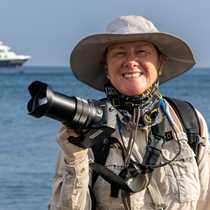Urbina Bay & Punta Moreno, Isabela Island
I woke up early today, but wasn’t the only one to do so. Ernesto, another staff member had beaten me to the deck, binoculars in hand. We both searched the slopes and rim of Fernandina Volcano, then Wolf Volcano, then any of the others in view, hoping against hope for signs of a volcanic eruption. As you read in yesterday’s Daily Expedition Report, we felt strong earthquakes in the afternoon, followed by clouds of ash and dust. This morning dawned clear and cloudless. Oh well, we can only hope that before the day was out we might see more action in the area.
The Zodiacs took us to shore in Urbina Bay, wedged between Darwin and Alcedo Volcanoes on the western side of Isabela. In this small bight, several square miles of shoreline were abruptly up-lifted in 1954 in a manner so gentle the marine creatures hiding for their lives in the coral heads were exposed to air and over the years bleached by the equatorial sun. A small boat’s crew noticed a five-mile stretch of coastline shining bright white in the sun. On further investigation it was discovered to be the sea floor above sea-level, corals and marine inhabitants alike. Everything lay undisturbed, fragile exoskeletons delicate in their exposed and dried state.
Today we hiked through the over-grown garden of corals, fifty years out of the ocean. Land iguanas now roam where lobsters once wandered. A small giant tortoise was found hiding from the heat inside an (abandoned?) land iguana burrow. Hawks called overhead while mockingbirds sang and finches twittered.
The beach was ideal. The temperature of the water wasn’t as cold as we expected, and on our return to the Islander we started a mad series of jumps from the upper decks. Repeated jumps were necessary in order to get the perfect family photo, of course.
The afternoon was spent crossing a corrugated and fractured landscape of barren lava at Punta Moreno, off Cerro Azul Volcano. Several oasis of green, small lagoons are connected to the sea through fissures deep underneath this harsh field of black and gray. Flamingos, stilts and ducks find a home here, isolated by miles and miles from other inhabitable areas of similar wetness. Zodiacs cruised slowly the still inlets where golden rays, spotted eagle rays, turtles and penguins shared mangrove-enclosed pools (wow! Penguins and mangroves together!).
As the sun set, no further activity from the volcanoes of Isabela and Fernandina were seen.
I woke up early today, but wasn’t the only one to do so. Ernesto, another staff member had beaten me to the deck, binoculars in hand. We both searched the slopes and rim of Fernandina Volcano, then Wolf Volcano, then any of the others in view, hoping against hope for signs of a volcanic eruption. As you read in yesterday’s Daily Expedition Report, we felt strong earthquakes in the afternoon, followed by clouds of ash and dust. This morning dawned clear and cloudless. Oh well, we can only hope that before the day was out we might see more action in the area.
The Zodiacs took us to shore in Urbina Bay, wedged between Darwin and Alcedo Volcanoes on the western side of Isabela. In this small bight, several square miles of shoreline were abruptly up-lifted in 1954 in a manner so gentle the marine creatures hiding for their lives in the coral heads were exposed to air and over the years bleached by the equatorial sun. A small boat’s crew noticed a five-mile stretch of coastline shining bright white in the sun. On further investigation it was discovered to be the sea floor above sea-level, corals and marine inhabitants alike. Everything lay undisturbed, fragile exoskeletons delicate in their exposed and dried state.
Today we hiked through the over-grown garden of corals, fifty years out of the ocean. Land iguanas now roam where lobsters once wandered. A small giant tortoise was found hiding from the heat inside an (abandoned?) land iguana burrow. Hawks called overhead while mockingbirds sang and finches twittered.
The beach was ideal. The temperature of the water wasn’t as cold as we expected, and on our return to the Islander we started a mad series of jumps from the upper decks. Repeated jumps were necessary in order to get the perfect family photo, of course.
The afternoon was spent crossing a corrugated and fractured landscape of barren lava at Punta Moreno, off Cerro Azul Volcano. Several oasis of green, small lagoons are connected to the sea through fissures deep underneath this harsh field of black and gray. Flamingos, stilts and ducks find a home here, isolated by miles and miles from other inhabitable areas of similar wetness. Zodiacs cruised slowly the still inlets where golden rays, spotted eagle rays, turtles and penguins shared mangrove-enclosed pools (wow! Penguins and mangroves together!).
As the sun set, no further activity from the volcanoes of Isabela and Fernandina were seen.




